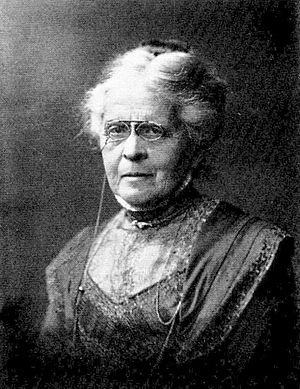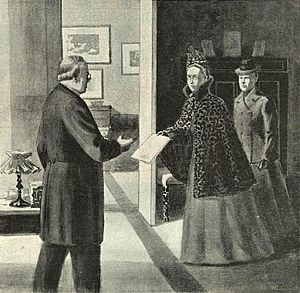Agda Montelius facts for kids
Quick facts for kids
Agda Montelius
|
|
|---|---|
 |
|
| Born | 23 April 1850 Köping, Sweden
|
| Died | 27 October 1920 Stockholm, Sweden
|
| Known for | Philanthropist, woman's rights activist |
| Spouse(s) | Oscar Montelius (1843–1921) |
Agda Georgina Dorothea Alexandra Montelius (born April 23, 1850 – died October 27, 1920) was an important Swedish woman. She spent her life helping others and fighting for women's rights. She was a leading figure in Swedish charity work. Agda also worked hard for women to get the right to vote. From 1903 to 1920, she was the head of the Fredrika Bremer Association, a group that supported women's rights.
Contents
About Agda Montelius
Agda Montelius was born in Köping, Sweden, in 1850. Her father, Alexander Reuterskiöld, was a high-ranking military officer. Her mother was Anna Schenström. Agda went to a well-known girls' school in Stockholm called Hammarstedtska flickskolan.
On September 20, 1871, she married Oscar Montelius. He was a famous Swedish archaeologist and professor.
People described Agda as a quiet, kind, and thoughtful person. She was always busy with her many projects. She had poor eyesight and eventually lost sight in one eye. She lived by simple and strict personal rules.
Agda Montelius was seen as an important and inspiring person among the upper-class women in Stockholm.
Helping Others: Philanthropic Work
Agda Montelius was a top leader in Swedish charity work in the early 1900s. Her main idea was to help people learn to help themselves.
She was involved in many groups that aimed to help society:
- She was a member (1885–1901) and chairperson (1900–1901) of the women's society Nya Idun.
- She worked with the Maria Protection Society from 1879 to 1892.
- She helped start and led the Föreningen för välgörenhetens ordnande (Society of Organised Charity) or FVO from 1889 to 1911. She also managed its main committee from 1911 to 1920.
- She was part of the main committee for the Society for the Encouragement of Tender and Decent Motherly Care from 1901 to 1920.
- She co-founded and was a committee member of the Central Committee of Social Work (CSA) from 1903 to 1909.
- She was also involved with the Swedish Poor Care Society from 1909 to 1920.
Fighting for Women's Rights
Her charity work also led her to fight for women's rights. She believed it was important for women to be involved in politics. This would help protect the rights of those who were sick, weak, or in need. She wanted society to feel more like a home for everyone.
In 1886, Montelius officially joined the Fredrika Bremer Association (FBF). She had actually helped start this group two years earlier. At first, a man named Hans Hildebrand was the official head of the FBF. This was because Sophie Adlersparre thought a man's leadership would make the group taken more seriously. But in reality, Adlersparre was the true leader. When Adlersparre passed away in 1895, Agda Montelius took over. She was first called vice chairman, but in 1903, she officially became the first female chairperson of the FBF.
The FBF's goal was to work for women's rights. However, it had not worked for women's suffrage (the right to vote) before. In 1899, a group from the FBF presented a request for women's suffrage to Prime Minister Erik Gustaf Boström. Agda Montelius led this group. Gertrud Adelborg, who wrote the request, was with her. This was the first time Swedish women had officially asked for the right to vote.

In 1902, the Swedish National Association for Women's Suffrage (LKPR) was founded. Agda Montelius never officially joined this group. This was likely because she was already leading the FBF. However, she helped the LKPR in many ways. She allowed the FBF's resources and members to assist the LKPR. She also let the FBF's newspaper, Dagny, be the voice for the LKPR until 1911. In 1911, the LKPR decided to boycott political parties that opposed women's suffrage. Because of this, Agda stopped Dagny from being the LKPR's newspaper.
In 1912, she worked as an advisor for a government committee. This committee was working to change marriage laws. These changes eventually led to husbands and wives having equal rights in marriage by 1920.
Working for Peace
Agda Montelius was also active in the peace movement. During World War I, the LKPR started a peace group. This group was made up of women from neutral countries. Their goal was to pressure neutral governments to help end the war. The Peace Movement included members from the Fredrika Bremer Association, KFUK, and social democratic women's groups.
A large peace event was planned for February 19, 1915. It was organized by Swedish women, with support from women in Denmark and Norway. However, on February 18, Agda Montelius was called to meet Queen Victoria of Baden. The Queen demanded a stop to "The foolish presumption of women" getting involved in politics. King Gustaf V of Sweden then said that women could present requests to the government. But he added that the current situation made it difficult. The King referred the matter to Knut Wallenberg, the Minister for Foreign Affairs. Wallenberg warned them that their actions could harm Sweden's neutrality. Because of this, the peace event was stopped in Sweden, Norway, and Denmark. However, the Swedish Peace Movement did send 16 delegates to the International Congress of Women in The Hague in April 1915.
Award
In 1910, she received the Swedish Royal Medal Illis Quorum. This award is given to people for their outstanding contributions to Swedish culture, science, or society.
See Also

